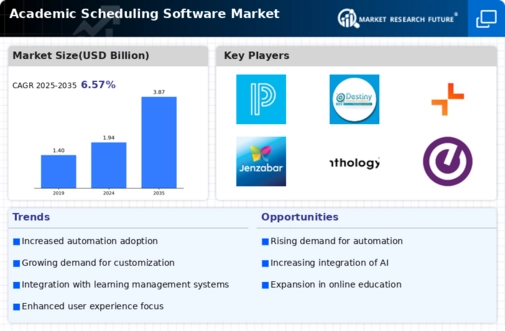Market Growth Projections
The Global Academic Scheduling Software Market Industry is poised for substantial growth, with projections indicating a market size of 1.94 USD Billion in 2024 and an anticipated increase to 3.87 USD Billion by 2035. This growth trajectory suggests a compound annual growth rate (CAGR) of 6.49% from 2025 to 2035. Such figures reflect the increasing adoption of scheduling software by educational institutions worldwide, driven by the need for efficiency, compliance, and enhanced student experiences. The market dynamics indicate a robust demand for innovative solutions that address the complexities of modern educational environments.
Integration of Advanced Technologies
The integration of advanced technologies such as artificial intelligence and machine learning is a pivotal driver in the Global Academic Scheduling Software Market Industry. These technologies enable institutions to automate scheduling processes, predict resource needs, and adapt to changing circumstances. The ability to analyze vast amounts of data allows for more informed decision-making, which is crucial in today’s dynamic educational environment. As institutions increasingly adopt these technologies, the market is expected to grow significantly, with projections indicating a rise to 3.87 USD Billion by 2035. This technological evolution not only streamlines operations but also enhances the adaptability of scheduling systems.
Expansion of Online Learning Platforms
The expansion of online learning platforms is a significant driver in the Global Academic Scheduling Software Market Industry. As more institutions adopt hybrid and fully online learning models, the need for robust scheduling solutions that accommodate both in-person and virtual classes has become paramount. Scheduling software must now integrate features that support diverse learning environments, including real-time updates and flexible scheduling options. This shift is indicative of a broader trend towards digital transformation in education. Consequently, the market is poised for substantial growth, with projections suggesting a rise to 3.87 USD Billion by 2035, as institutions adapt to the evolving educational landscape.
Regulatory Compliance and Standardization
Regulatory compliance and standardization are becoming increasingly critical in the Global Academic Scheduling Software Market Industry. Educational institutions are required to adhere to various regulations regarding course offerings, faculty qualifications, and student enrollment. Scheduling software that incorporates compliance features helps institutions avoid potential legal issues and ensures that they meet accreditation standards. As the regulatory landscape evolves, institutions are turning to sophisticated scheduling solutions that can adapt to these changes. This focus on compliance is likely to drive market growth, as institutions seek to mitigate risks associated with non-compliance while optimizing their scheduling processes.
Growing Focus on Student-Centric Scheduling
There is a notable shift towards student-centric scheduling in the Global Academic Scheduling Software Market Industry. Institutions are recognizing the importance of accommodating student preferences and needs in scheduling processes. This trend is driven by the desire to enhance student satisfaction and retention rates. By utilizing scheduling software that allows for personalized timetables, institutions can better align course offerings with student demand. This approach not only improves the educational experience but also contributes to higher enrollment rates. As a result, the market is anticipated to grow at a CAGR of 6.49% from 2025 to 2035, reflecting the increasing emphasis on student engagement.
Increasing Demand for Efficient Resource Management
The Global Academic Scheduling Software Market Industry experiences a surge in demand for efficient resource management solutions. Educational institutions are increasingly seeking software that optimizes the use of classrooms, faculty, and equipment. This trend is driven by the need to enhance operational efficiency and reduce costs. In 2024, the market is projected to reach 1.94 USD Billion, reflecting a growing recognition of the importance of effective scheduling. Institutions are leveraging advanced algorithms and analytics to streamline their scheduling processes, which not only improves resource allocation but also enhances the overall educational experience for students and faculty alike.






















Leave a Comment